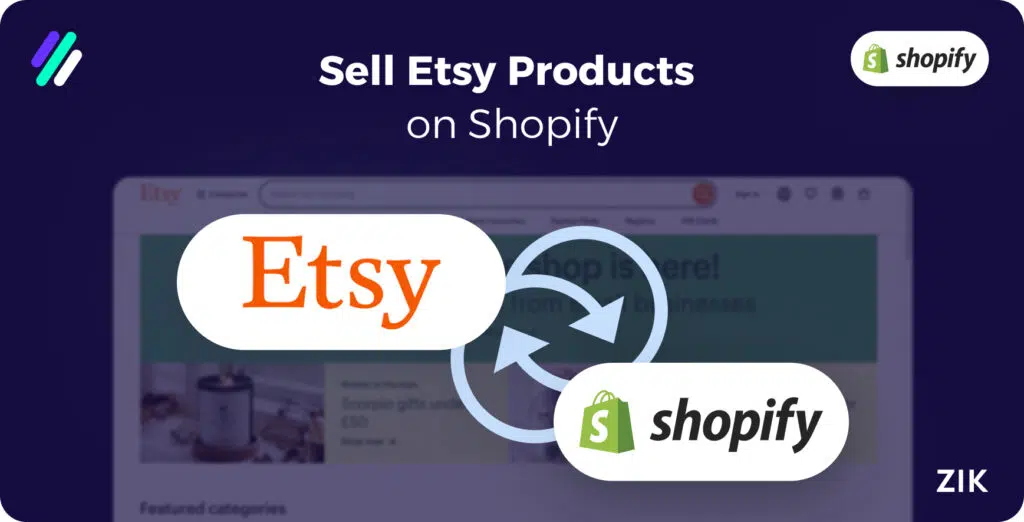Did you know that you can integrate Etsy with Shopify?
Why limit your online business to just one ecommerce platform when you can reach more potential customers with both? Selling on Etsy offers opportunities to target a specific audience.
For example, the Etsy community is known as the best marketplace for handmade goods. But what if I told you you can showcase your Etsy products on your Shopify store?
As a seasoned online business owner, I understand the importance of knowing your customer base. When you sell to a target audience, you can increase your chances of making more sales because you sell products to people interested in buying them.
While developing our market research tool, ZIK Analytics, I also realized the value of data analytics. Keeping track of sales data and understanding the preferences of your customer base unlocks the potential for more sales.
You can tweak your Shopify marketing and selling strategy to appeal to your customers! Looking at how other sellers advertise can be helpful too. Tools like Adspy make it easier to spot what kinds of Etsy-style products are already performing well on Facebook and TikTok, so you can adapt those strategies when promoting your own Shopify store.
This guide will help you how to sell Etsy products on Shopify! If you want to showcase your products to a wider audience and leverage the tools available on Shopify, you’ve come to the right place.
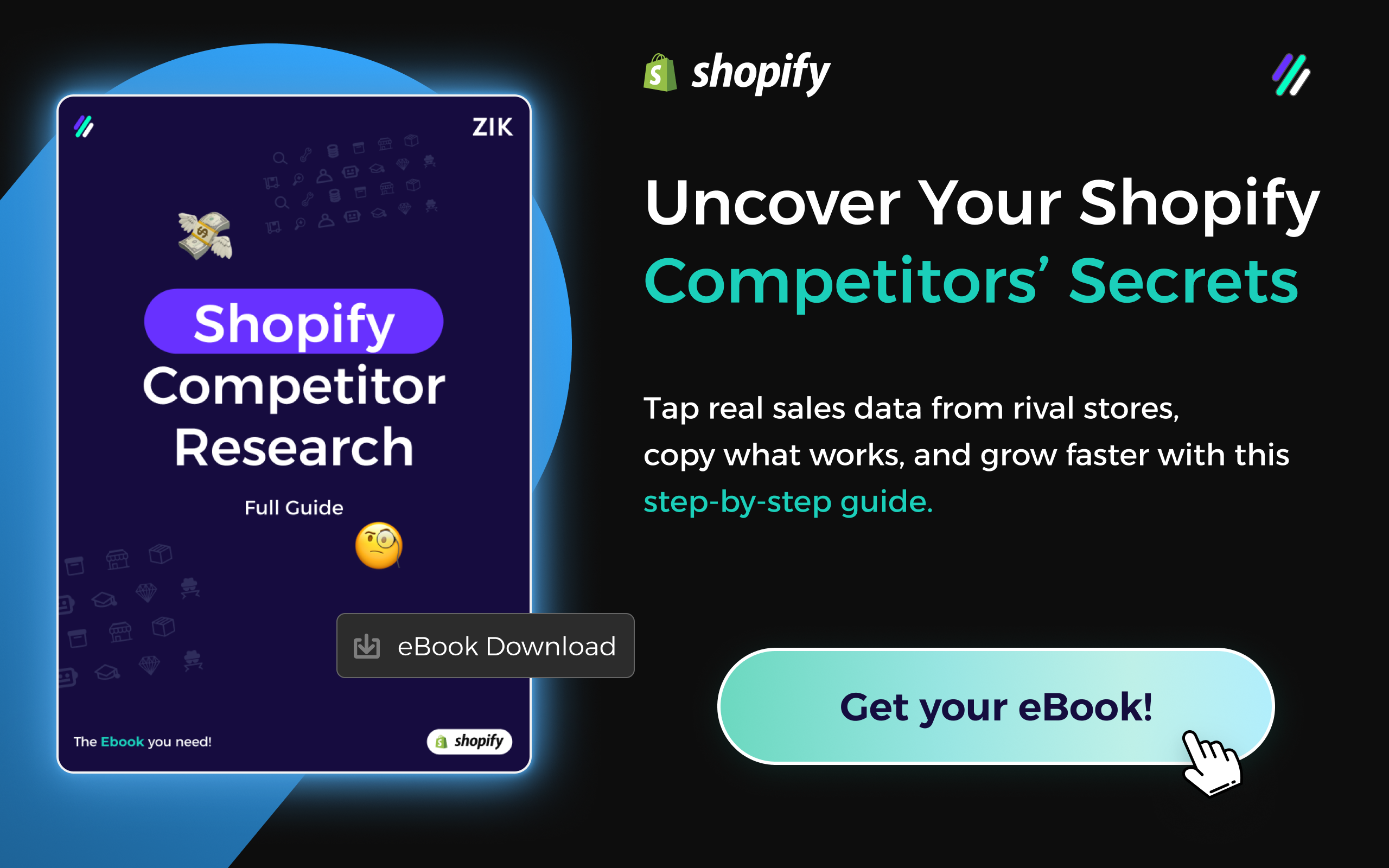
Key Takeaways
- Use third-party apps to sync and automatically integrate your Etsy store products to Shopify for real-time syncing.
- Use our ZIK Analytics market research tool to identify top-selling handmade items with a huge sales potential.
- Double-check to ensure the chosen products have a sustainable inventory before listing them on Shopify. Handmade items and creative goods are not mass-produced, so it is a good idea to check to ensure that you will never run out of stock in case there is a high demand.
- Follow the best practices for selling on Shopify and Etsy to optimize sales in both marketplaces.
Step-by-Step Guide to Selling Etsy Products on Shopify
Follow this detailed guide to sell products from Etsy to your Shopify store.
Step 1. Assess Your Etsy Shop Inventory
Before you connect Shopify with your Etsy shop, you must identify your best-selling products on Etsy. Distinguish which products are doing well, which are seasonal items, and which are slow-moving items.
This step is crucial in choosing the best products from your Etsy stores that you can list on your Shopify store. It maximizes the Etsy listings on Shopify to ensure maximum exposure and sales conversions.
Step 2: Set Up Your Shopify Store
If you don’t have an account on Shopify yet, create one to start building your online store. If you already have an existing Shopify account, you can skip this step and move on to connecting your Etsy and Shopify stores.
Step 3: Integrate Shopify and Etsy
You can use Shopify’s native tools or third-party apps when integrating Etsy and Shopify. The Shopify App Store provides several options for apps that facilitate this integration.
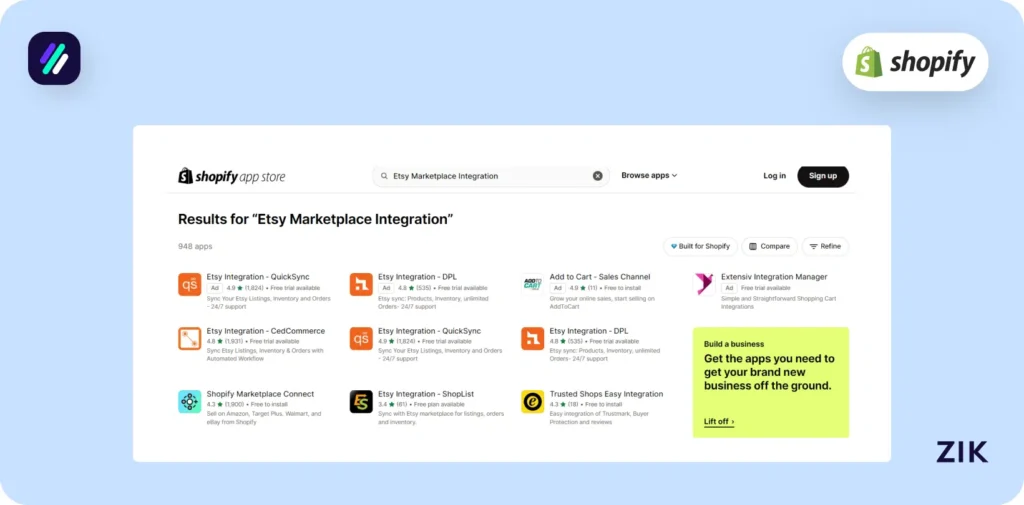
The first option is Etsy Integration – QuickSync. Use this app to easily and quickly integrate Shopify and Etsy, allowing you to move your Etsy inventory, product listings, and orders to the Shopify ecommerce platform.
Order syncing occurs in real time with updated product details, including your SKUs, barcodes, prices, variants, and more. It is advantageous when you are dealing with multiple products.
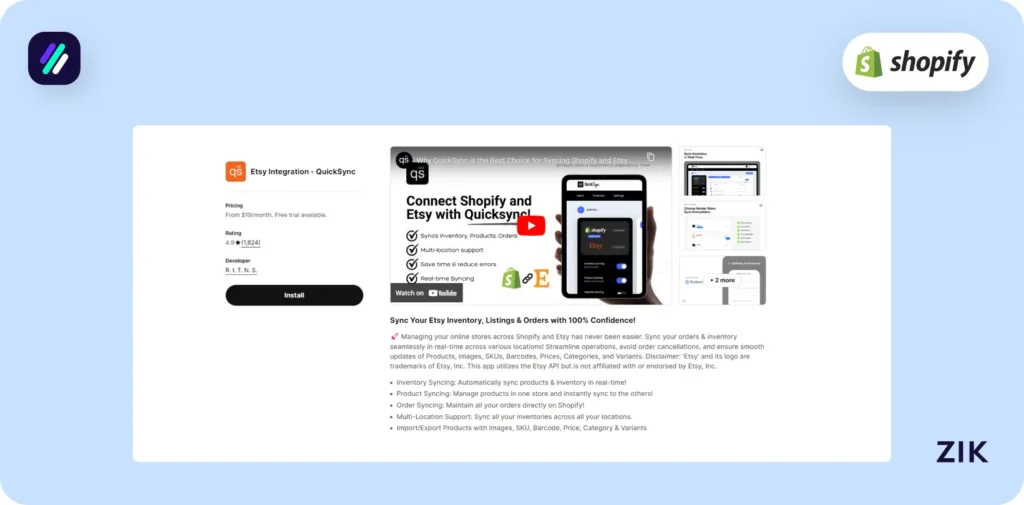
Another option is Etsy Integration – CedCommerce. This app allows bulk listing and product updates from Etsy to Shopify.
The seamless syncing of inventory and pricing ensures you can quickly start selling on both platforms with updated product pages.
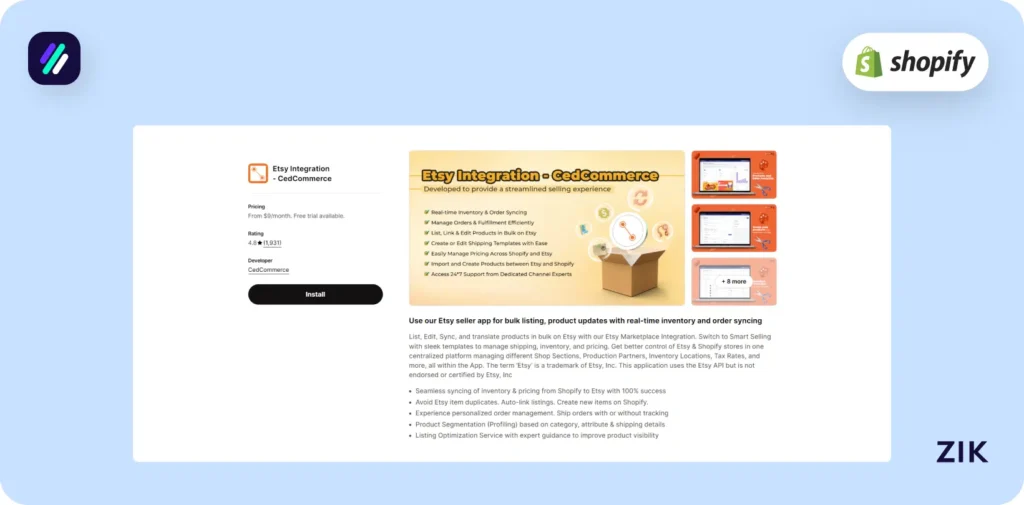
Meanwhile, Etsy Integration – ShopList is another app for integrating Shopify and Etsy products. Eliminate the manual work of syncing your inventory from Etsy to Shopify, as this app does that automatically.
Use this app to export and list products from your Etsy shop in bulk while syncing Etsy listings in real time. It saves you time and effort while ensuring your business can reach a wider audience instead of being limited to one platform.
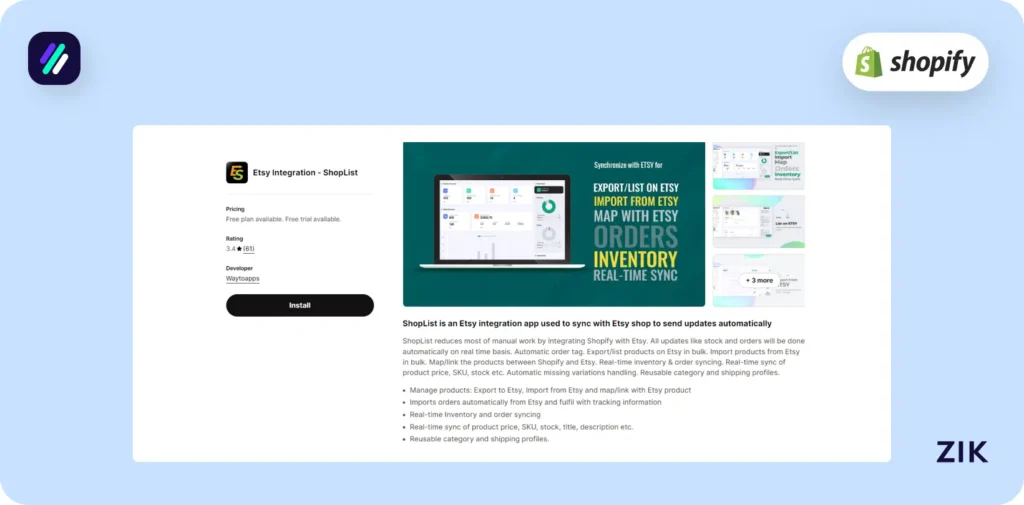
Since several apps are needed to integrate from one marketplace to another, you can review the features list or try out which apps work best for you.
Step 4: Optimizing Your Product Pages
Once you move your Etsy listings to Shopify, the next step is to use search engine optimization for your products on Shopify stores.
Follow the best practices and guidelines to reach a wider audience. It’s not enough that your products are listed on Shopify. While the Etsy community is smaller compared to Shopify stores, you can expect higher competition when selling on Shopify.
Therefore, you must utilize our product research tool to identify winning products from Etsy that will boost your shop sales. It keeps you informed about the search trends and sales history of certain products, enabling you to forecast trends and identify opportunities before other sellers do.
Identify the unique advantages of your products and showcase them in your listings. Selling on Etsy is no different than on Shopify. Your success lies in your ability to target the keywords your potential customers are looking for so that your products appear in the search results.
However, providing product details relevant to your customers’ needs is equally important. While optimizing your listings, make sure to make them useful to humans, too.
Choosing Winning Products from Etsy to Sell on Shopify
As I mentioned above, using data analytics and our market research tool, is the secret to the successful integration of Shopify and Etsy. Relying on data insights can help store owners reach a broader customer base.
It helps identify the best-selling products from Etsy that you can integrate into your Shopify online store and boost your brand performance on both platforms.
Log into your ZIK dashboard and use the Shopify Product Explorer tool to do this.
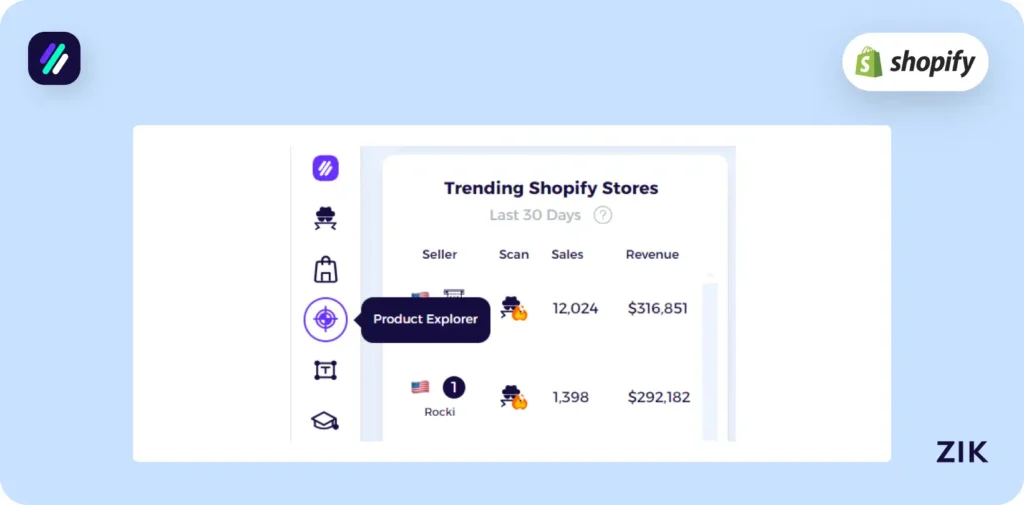
In the search field, you can input any keyword. But since the Etsy is known for its handmade goods and craft supplies, you can add the keyword “handmade” to the search bar to find the best selling handmade items on Shopify.
Since Shopify customers differ from the Etsy community, researching what handmade products are doing well on Shopify allows you to find the most profitable product ideas.
Data-backed research using our tool makes product selection easier and more effective.
Click Search to generate product ideas on Shopify. You can get an idea on the best-selling
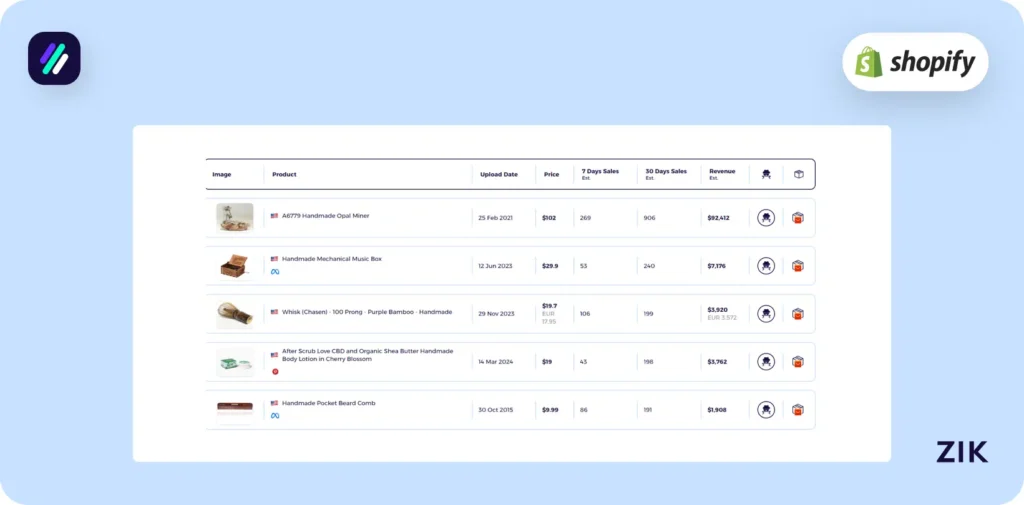
Let’s look at this product, for example. This listing is for a handmade mechanical music box priced at $29.90. The Shopify seller also offers free worldwide shipping and a 30-day refund guarantee.
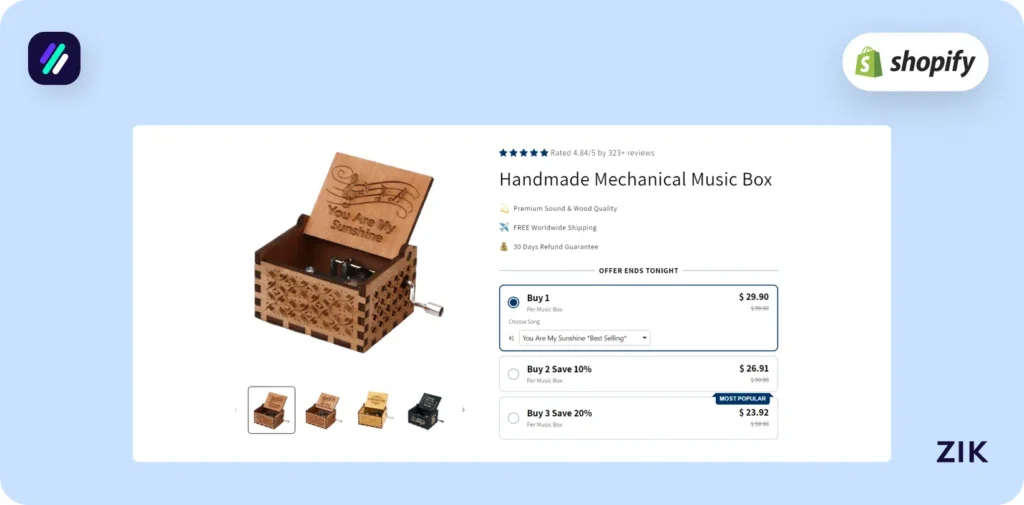
According to ZIK Analytics, the handmade music box has sold 240 times in the last 30 days and 53 times in the last seven days.
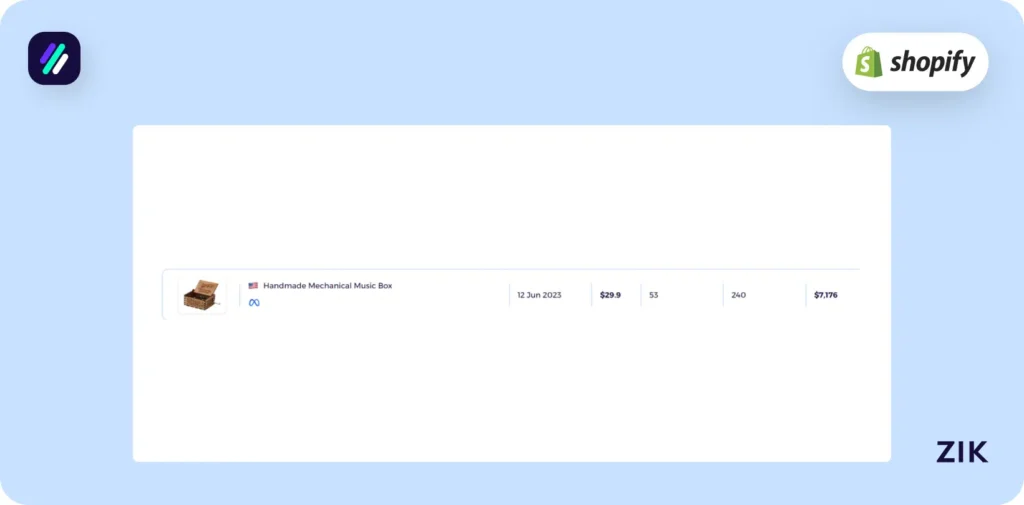
Let’s check another example: a handmade body lotion listed for $19.
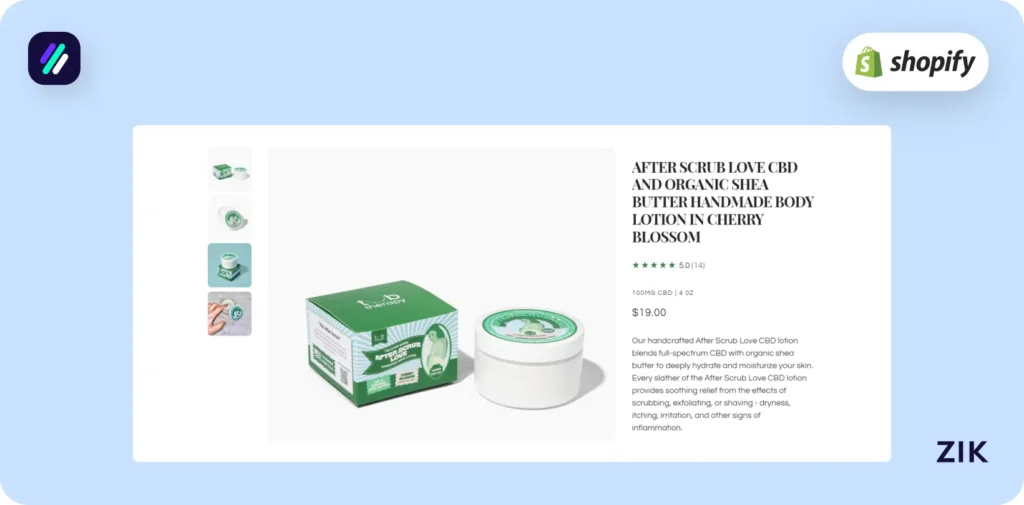
This product sold 198 times in the last 30 days and 43 times in the past week, earning the seller a revenue of $3,762 in the last 30 days!
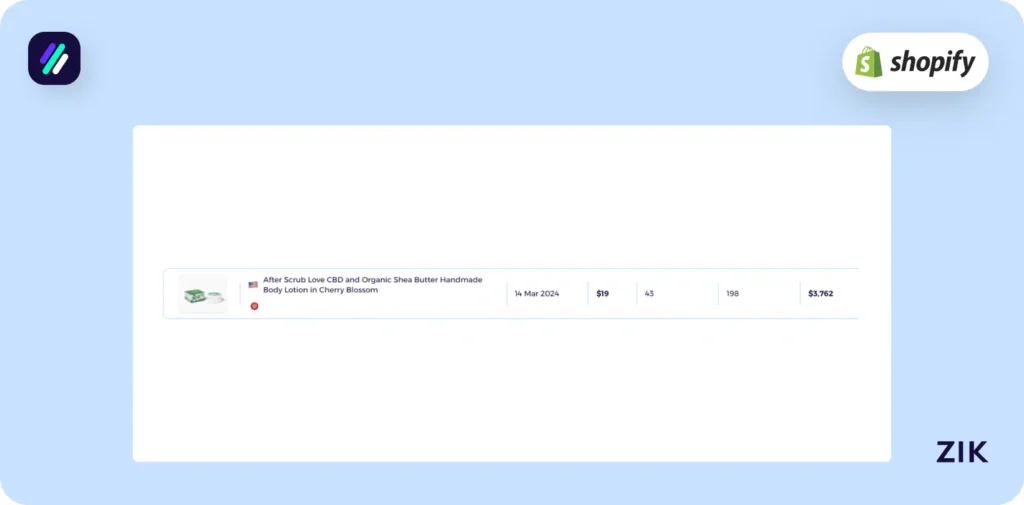
The next step is to examine the product more closely to see if it would be a good addition to your Shopify product listings. What should you look for when choosing products from Etsy for your Shopify store?
The first thing to consider is the sales data. This example of a handmade non-stick cast iron work has good sales data. It sold 105 times in the last 30 days and 17 times in the last seven days. This product is listed for $95.95.
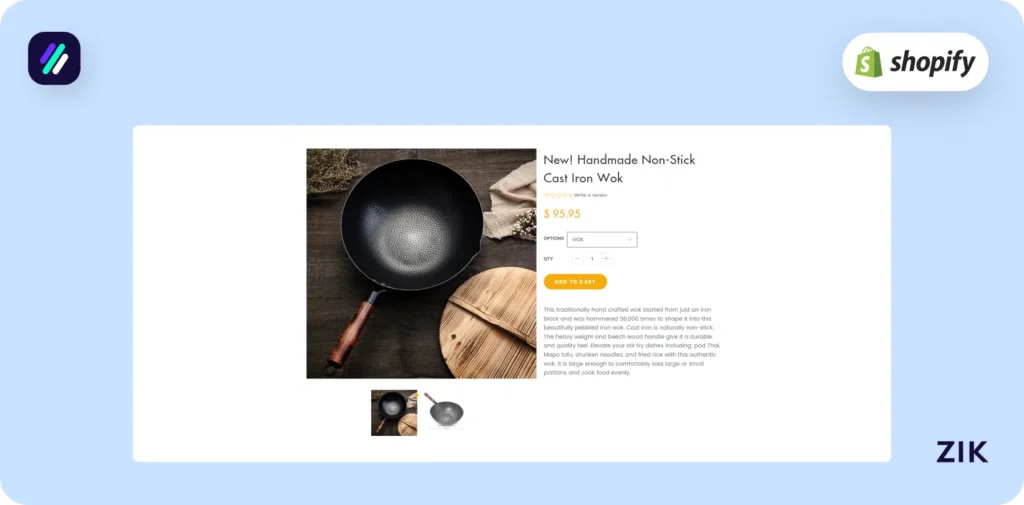
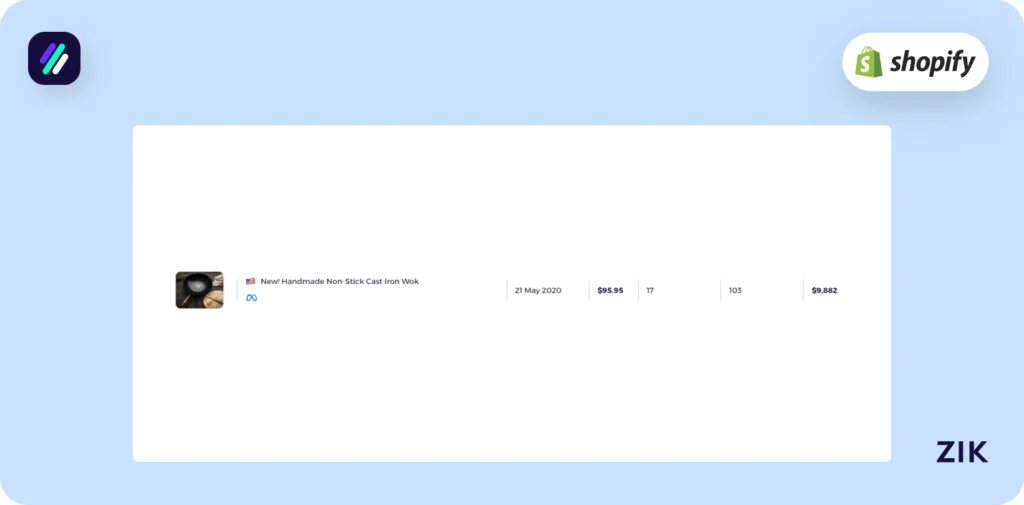
When I examined this Shopify seller, I discovered they have 28 products in their online store. Those 28 products generated 1,039 sales in the last 30 days and $35,332 in revenue.
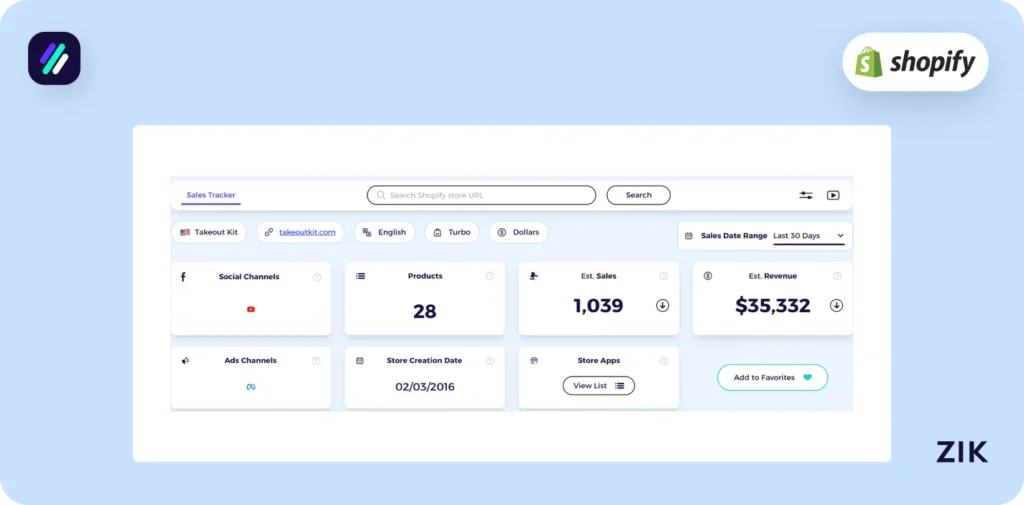
Now that we have confirmed that this product is doing well on Shopify, it’s time to find a similar product on Etsy. To find this on Etsy, you can target the same keywords as the original product listing on Shopify.
This search generated many possible results that I can use when integrating Etsy and Shopify.
However, I wanted to make sure that the product I chose from Etsy is priced lower than the Shopify product listing ($95.95). This ensures that you have enough room for your Shopify fees and your profit margin.
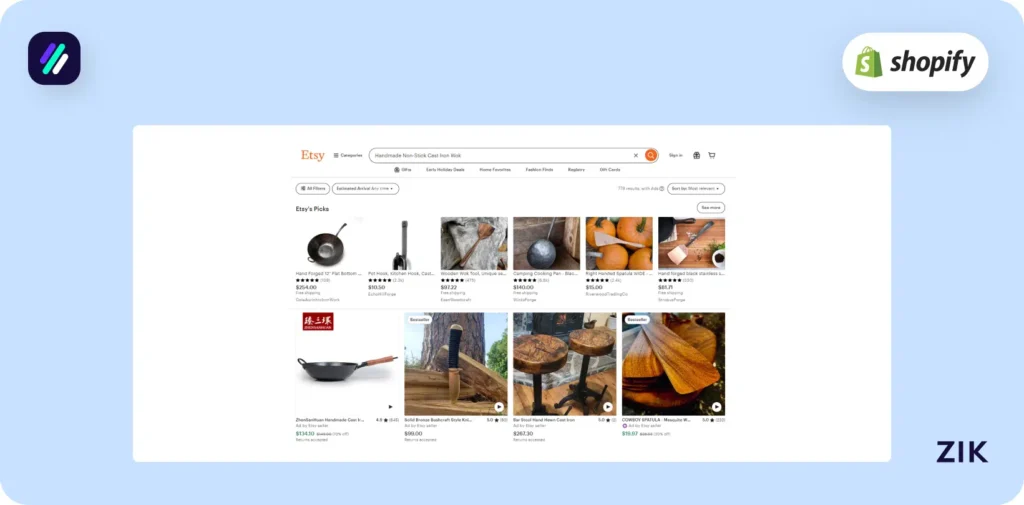
In this case, the product I found on Etsy qualifies because it is listed for $65.99. Also, checking out the images of the product closely resembles that on Shopify.
Therefore, potential buyers looking for a handmade cast iron wok with a wooden handle will find this product and consider buying it.
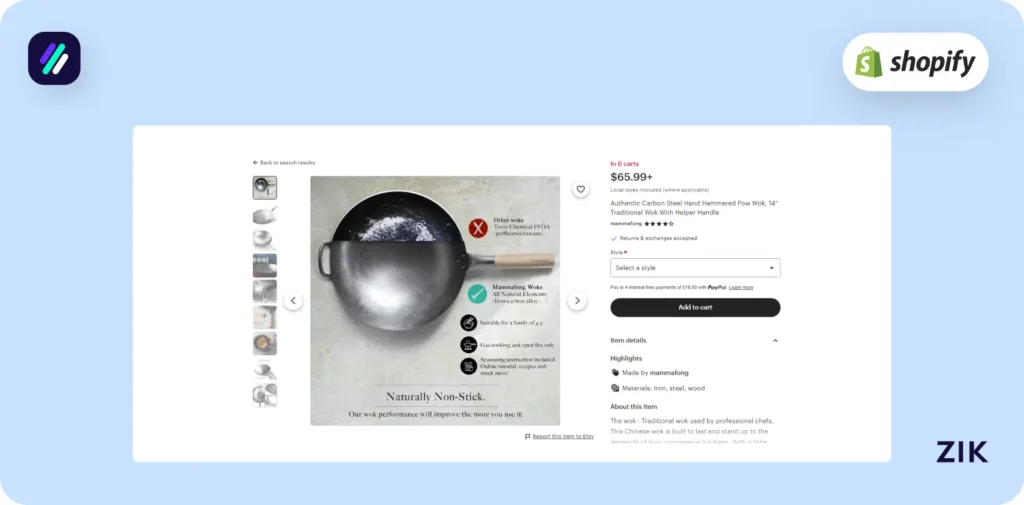
Another thing to consider is ensuring there is enough stock available for this product. To do this, go to the Etsy shop’s home page.
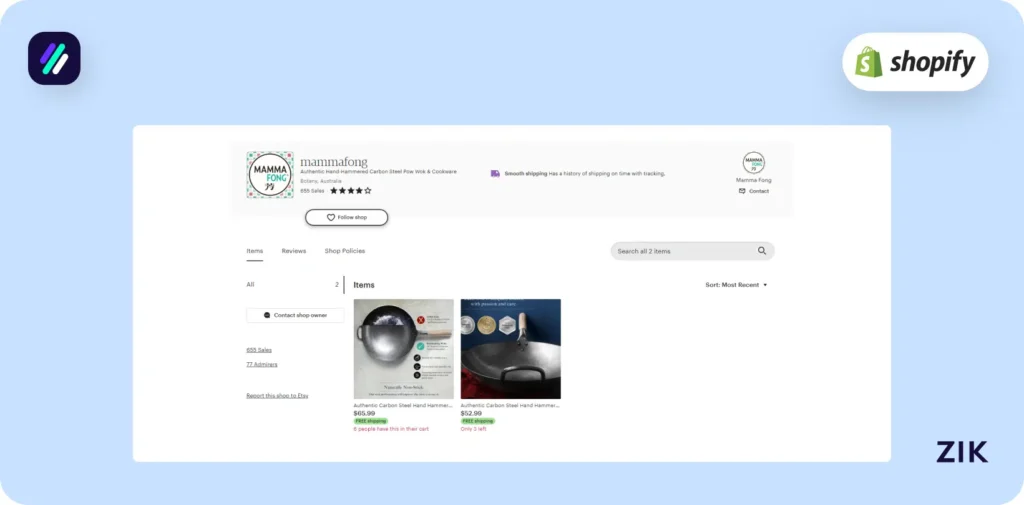
This seller has two products on their Etsy store, including the handmade cast iron wok. You can now check their sales to verify the availability of this product.
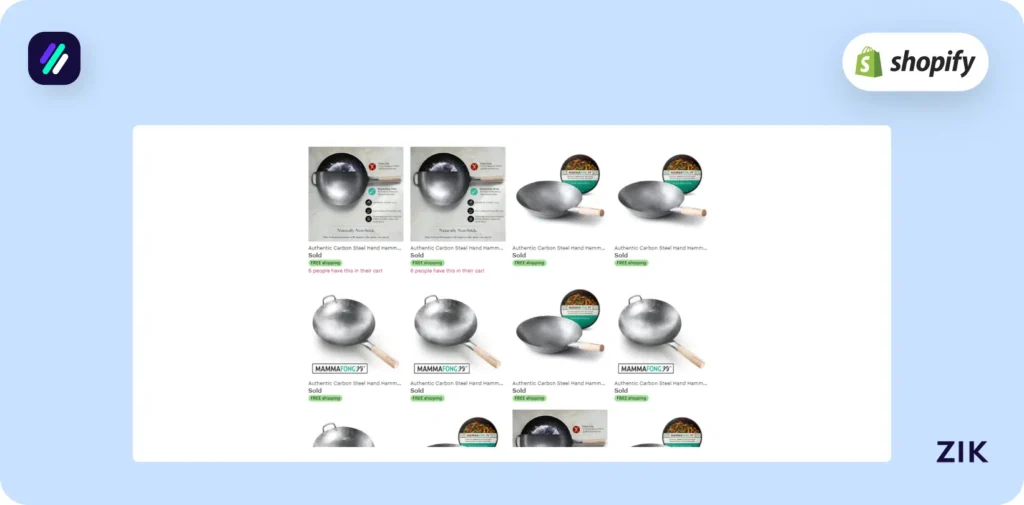
They’ve had over 600 sales, and those sales are for handmade cast iron work. Therefore, it confirms the availability of this product. The listing also states that 6 Etsy users have this item in their cart, showcasing that this product is in high demand with active buyers.
Another tactic to check if the product is available is to add it to your cart. Go to your Etsy account and add the product to see if it’s available.
So, why is it important to double-check the product availability on Etsy? It’s simple—your goal is to sell many of these products on your Shopify store.
Therefore, you want to promote a positive customer experience by ensuring that you can pack and ship the items to your customers when they order them. If the product is out of stock, your buyers must wait longer.
This could hurt your sales potential, so checking the inventory first is best.
Use this method to find Etsy products with high sales potential before integrating Shopify and Etsy. Product and market research informs your decisions with data and not just basing them on a hunch or trends online.
ZIK Analytics empowers your decision by giving access to relevant and updated sales information to help you decide if a product is worth adding to your online store.
Get insider tips—download the eBook on Shopify competitor research now!Final Thoughts on How to Sell Etsy Products on Shopify
Expanding your products from Etsy to Shopify allows your products to reach more eyeballs. And with higher visibility, you improve your chances of making more sales.
Using our product research tool, arm yourself with crucial information that helps identify the best-selling opportunities online. You can leverage data insights that go beyond social media trends and are based on actual sales to have success in both Shopify and Etsy stores.
Sell Etsy Products Smarter with Shopify Tools
Want to scale your Etsy product sales on Shopify? Use Shopify AI store builder to build a sleek, optimized store in minutes. Then, track performance with Shopify sales tracker to monitor what’s working, what’s selling, and where you can improve. Use AdSpy to analyze top-performing Etsy-style ads so you can position your listings to convert. These tools make it easier to grow your multi-platform business without the guesswork.
Frequently Asked Questions About How to Sell Etsy Products on Shopify
Here are some frequently asked questions about selling Etsy products on Shopify:
Can I sell Etsy products on Shopify?
Yes, you can sell Etsy products on Shopify if you own the rights to those items or create them yourself. Shopify also offers integrations to sync listings and inventory from Etsy. Just ensure compliance with Etsy’s terms and copyright laws when cross-listing.
What is not allowed to sell on Shopify?
Shopify prohibits products that are illegal, unsafe, or regulated, including drugs, weapons, counterfeit goods, gambling services, and adult content that violates laws. Restricted financial services, multi-level marketing schemes, and copyrighted materials without permission are also banned. Sellers must follow Shopify’s Acceptable Use Policy strictly.
Is it cheaper to sell on Etsy or Shopify?
Etsy is cheaper for beginners since there’s no monthly fee, but sellers pay listing and transaction charges that add up. Shopify requires a subscription, yet lower transaction rates make it more cost-effective long term, especially for higher sales volume or larger product catalogs.
What are the cons of using Shopify?
The cons of Shopify include monthly subscription fees, added transaction costs unless using Shopify Payments, and reliance on paid apps for advanced features. Customization beyond templates often requires coding, which can frustrate beginners seeking simplicity, making overall expenses higher compared to some alternative platforms.
Should I sell on both Shopify and Etsy?
Yes, selling on both Shopify and Etsy can maximize reach. Etsy provides built-in traffic from its marketplace, while Shopify gives you control over branding and customer relationships. Using both diversifies income streams, balances risk, and captures different audiences for long-term growth.
Do I need a business license to sell on Shopify?
You don’t always need a business license to sell on Shopify, as requirements depend on local laws and what you sell. Many start as sole proprietors without one, but registering a business can provide tax advantages, legal protection, and greater credibility.
Why choose Shopify over Etsy?
Choose Shopify if you want full control over branding, customer data, and pricing with scalability for growth. Unlike Etsy’s competitive marketplace, Shopify lets you build a standalone store, avoid listing fees, and create a long-term business identity while maintaining lower transaction costs at scale.
How do I add Etsy listings to Shopify?
You can add Etsy listings to Shopify by using integration apps like Etsy Marketplace Integration or manual CSV imports. These tools sync product details, inventory, and orders between platforms, making it easier to manage sales while expanding reach across both Etsy and Shopify.
How do I connect my Shopify store to Etsy?
You can connect Shopify to Etsy using third-party integration apps such as CedCommerce or ExportFeed, which sync products, inventory, and orders automatically. After installation, authorize your Etsy account, map product details, and configure settings to streamline multichannel selling between both platforms seamlessly.













